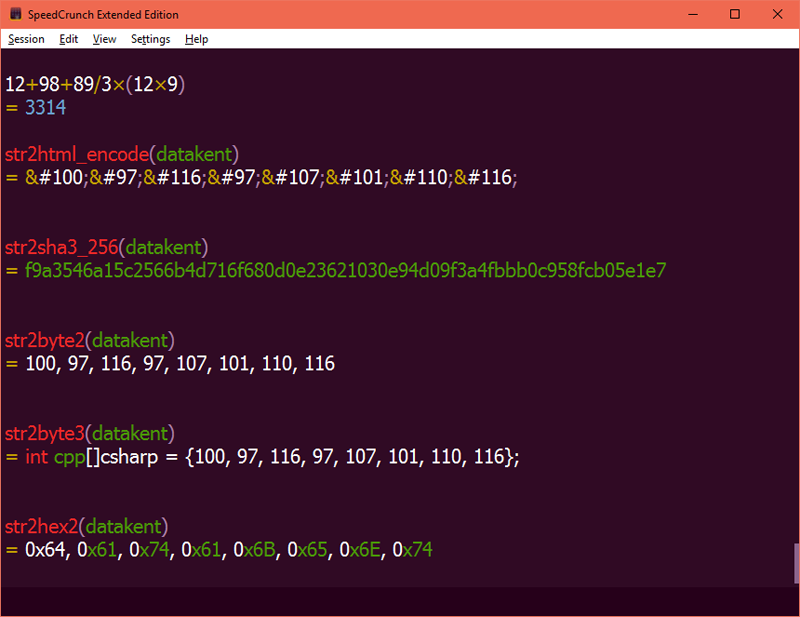

The rename command follows the same format as before. We can see from the ls command that our “.c” files are all prepended with “sl_”. We can remove a part of a filename by replacing the search term with nothing. We can verify the output of that command by repeating the ls command from above with the same parameters: Whenever “slang_” is found in a filename, it is replaced by “sl_”. This time we look for “.c” files and look for “slang_”. We’re just changing the search term, replacement term, and file type. The format of the command is already familiar to us. We are going to replace all occurrences of “slang_” with “sl_”.
#Speedcrunch strings code#
In the directory there are many C source code files. We have changed the filename extensions so far, let’s modify other parts of the filenames. The core part of the command, or core expression, is a Perl ” and is what gives the renaming command flexibility. The first term (.prog) is what the rename will look for in each file name, and the second term (.prg) is what it will replace with. The middle part defines the work we want to do on each filename. The last part is *.prog, which tells the renaming to operate on all “.prog” files. The first part is the name of the command, rename (or prename or perl-rename, for other distributions). Let’s explain that bit of magic, in three parts. That worked, now they are all “.prg” files and there are no “.prog” files left in the directory. Remember to replace the name change with the appropriate command name for your Linux if you are not using Ubuntu or a Debian-derived Linux. Now let’s use the following command to rename them. We will turn back the clock to have a set of “.prog” files. Sudo pacman -Syu perl-rename Let’s do it againĪnd this time we will use the name change. Note that the rename command is called perl-rename.
#Speedcrunch strings install#
To install it on Manjaro Linux use the following command. Note the initial “p”, which stands for Perl. On distributions derived from Fedora and RedHat, install a prename like this. On Ubuntu and Debian-derived distributions you install rename like this: You will just need to substitute the appropriate command name according to the flavor of Linux you are using. It also has a different name in different Linux families, but they all work the same way. Rename is not part of a standard Linux distribution, so you will need to install it. Instead, a new extension of “.prg” will be used. The new file will be named with the name of the original file excluding the “.prog” part. It uses mv to move each file to a new file.

The next part tells what the processing will do. The first part starts a loop that will process each “.prog” file in the directory, in turn. Here’s a way to do it that doesn’t resort to writing an actual Bash script file.įor f in *.prog do mv - “$f” “$.prg” How do we get mv to do that for us? Let’s take a look at the files. We want to rename them on the command line so they have a “.prg” extension. Some of these files have a “.prog” extension. Let’s say we have a directory with a variety of files, of different types. That’s fine if you know some mid-grade command line fu, but the complexity of renaming multiple files with mv belies the ease of using mv to rename a single file. You must resort to using some clever Bash tricks. mv does not have the ability to rename multiple files. Things get complicated when you want to rename multiple files. Mv oldfile.txt newfile.txt ls *.txt Rename multiple files with mv You can use ls to check that the file has been renamed. To use mv to rename a file, type mv, a space, the file name, a space, and the new name you want the file to have. But mv is not a dedicated file renaming tool. The net effect is to rename the file, so we get what we want. It’s a happy side effect that can be used to move an existing file to a new file, with a new name. The mv command has one purpose in life and that is to move files. But sometimes you just need an excavator, not a shovel. The command does, and is found on all Linux distributions, on macOS, and on other Unix-like operating systems. Here is a tutorial of this powerful command.

Renaming is flexible, fast, and sometimes even easier. Get acquainted with the file renaming power of the Linux world and give mv, and yourself, a break.
#Speedcrunch strings how to#
Command, linux How to use the rename command in Linux


 0 kommentar(er)
0 kommentar(er)
